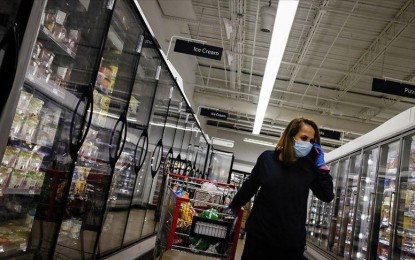
ISTANBUL – The Russia-Ukraine war has wreaked havoc on commodity and energy prices and countries around the world are struggling with high inflation, which is hitting record levels.
After a tough two years due to the coronavirus pandemic, the world economy was expected to recover quickly, but the war caused new problems for global markets.
The war, which began on February 24, has triggered significant increases in prices of commodities such as wheat, corn and sunflower seed oil.
In April, data from the UN's Food and Agriculture Organization showed that food prices rose by 29.8 percent on a yearly basis, while the increase was 46.4 percent for vegetable oils, 34.3 percent for cereals, 23.5 percent for diary, 21.8 percent for sugar and 16.9 percent for meat.
Wheat prices per ton, which were around $350 before the war, hit $500 following the beginning of Russia's military operation and are around the $400-$450 level currently.
The barrel price of Brent crude oil was around $93 in January, while it exceeded the $100 level after the war began in February and reached a record level of $110 in March. Its price was around $64.50 in February 2021 and $69.50 in May 2021, while it is around the $106 level currently.
Price increases
In the Organization for Economic Co-operation and Development (OECD) region, annual inflation was 8.8 percent in March, the largest increase since October 1988, while the figure was 2.4 percent in March 2021.
Around one fifth of OECD countries recorded double-digit inflation, with the highest rate in Turkiye at 61.1 percent, in March.
Energy price inflation in the region soared to 33.7 percent year-on-year in March, up from 26.6 percent in February.
Year-on-year inflation in the G20 area increased to 7.9 percent in March compared with 6.8 percent in February 2022.
The US annual inflation rate hit 8.3 percent in April after posting the largest 12-month rise in March since December 1981.
China’s annual inflation rate rose to 2.1 percent in April, up from 1.5 percent in March.
In Canada, the annual inflation rate was 6.7 percent in March, the highest level for 31 years.
The Netherlands saw a double-digit figure in the inflation rate of 11.2 percent in April.
Australia’s inflation rate also hit a 20-year-high of 5.1 percent in the first quarter of this year.
Inflation in Japan hit a 26-month high of 0.8 percent in March.
Meanwhile, Turkiye's annual inflation rate hit 69.97 percent in April.
European markets
The eurozone's annual inflation rate was at 7.5 percent in April, up from 7.4 percent in March and 1.6 percent in April 2021.
The main contributor of the price increases was energy, followed by food-alcohol-tobacco and non-energy industrial goods and services in April.
Germany's annual inflation was at 7.4 percent in April, an all-time high for the second month in a row.
In France, the annual inflation rate was 5.4 percent in April, while energy prices increased 26.6 percent in the country on a yearly basis.
Annual consumer inflation in the UK hit its highest-ever level of 7 percent in March.
Prices in Denmark increased by 6.7 percent year-on-year in April, the highest rise since 1984.
Annual inflation in Greece rose to 10.2 percent in April from 8.9 percent in the previous month, the first double-digit rate in 27 years.
The rate also reached 7.2 percent in Portugal in April, the highest level since March 1993, 6.2 percent in Italy and 8.3 percent in Spain.
Measures
Meanwhile, economic administrations all around the world tried to take measures to ease prices.
The International Monetary Fund (IMF) said in its World Economic Outlook report that inflation hovered above 5 percent in more than half of 40 countries classified as advanced economies and such high inflation has not been seen for more than 20 years.
According to the IMF's report in April, inflation is expected to reach 8.7 percent in developing economies this year.
The US Federal Reserve increased its policy rate by 50 basis points at its two-day meeting last week.
The Fed's aggressive move, the steepest rate hike since 2000, carried the benchmark rate to a range of 0.75 percent to 1 percent.
The Bank of England last week also raised interest rates by 25 basis points to 1 percent, the highest level since 2009, after another hike of 25 basis points in March.
Meanwhile, the European Central Bank (ECB) kept its key interest rates unchanged at its April meeting.
The governor of Germany's central bank, Joachim Nagel, recently called for taking measures to cope with rising inflation in the euro area.
If the incoming data signals for an interest rate hike in June, Nagel said he will advocate a first step normalizing ECB interest rates in July. (Anadolu)
